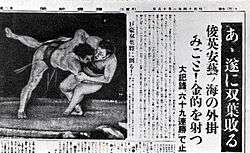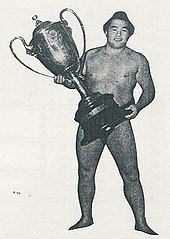Akinoumi Setsuo
Akinoumi Setsuo (Japanese: 安藝ノ海 節男, Hepburn: Akinoumi Setsuo, May 30, 1914 – March 25, 1979), born Nagata Setsuo (永田 節男), was a Japanese professional sumo wrestler from Hiroshima. He was the sport's 37th yokozuna.
| 安藝ノ海 節男 Akinoumi Setsuo | |
|---|---|
 | |
| Personal information | |
| Born | Nagata Setsuo May 30, 1914 Hiroshima, Japan |
| Died | March 25, 1979 (aged 64) |
| Height | 1.77 m (5 ft 9 1⁄2 in) |
| Weight | 127.5 kg (281 lb) |
| Career | |
| Stable | Dewanoumi |
| Record | 209–101–38 |
| Debut | February 1932 |
| Highest rank | Yokozuna (May 1942) |
| Retired | November, 1946 |
| Elder name | Fujishima |
| Championships | 1 (Makuuchi) 1 (Jonokuchi) |
| Gold Stars | 1 (Futabayama) |
| * Up to date as of June 2020. | |
Career

Akinoumi made his professional debut in February 1932 and reached the top makuuchi division in January 1938. He was the man who ended Futabayama's record 69 bout winning streak in January 1939. As he was only ranked as a maegashira at the time, it was regarded as an enormous upset. He defeated the yokozuna by sotogake, an outer leg trip. He had practiced this technique in training with Komanosato, who had been Futabayama's 69th and final defeated opponent. He was overwhelmed by his achievement, but was told by his stablemaster, "Become a rikishi not to be praised when he wins but to cause an uproar when he loses."[1]
His only top division championship came in May 1940 when he was ranked as a sekiwake. He earned promotion to yokozuna in May 1942 after two runner-up performances. Akinoumi was not a particularly successful yokozuna, lasting only eight tournaments at the rank and not managing to win any further championships. He is arguably better remembered for his victory over Futabayama than his exploits as a grand champion.[2]
Retirement from sumo
Akinoumi retired in November 1946, and became an elder of the Japan Sumo Association with the name of Fujishima. He married the daughter of Dewanoumi Oyakata, the former yokozuna Tsunenohana, but was unfaithful to her, his geisha mistress giving birth the same day that his wife did.[2] They were later divorced. This put an end to any hopes of becoming the head of Dewanoumi stable, and he left the sumo world in January 1955.[3] He later remarried. He ran a chanko restaurant, and when that went out of business, a clothing store. He also appeared as a sumo commentator on broadcasts of tournaments. He celebrated his 60th birthday in 1974 but for reasons which are unclear, did not get to perform the kanreki dohyō-iri ceremony. He died in 1979 of congestive heart failure.
Career record

- Through most of the 1930s and 1940s only two tournaments were held a year, and in 1946 only one was held.
| - | Spring Haru basho, Tokyo |
March Sangatsu basho, varied |
Summer Natsu basho, Tokyo |
October Jūgatsu basho, varied | ||
|---|---|---|---|---|---|---|
| 1932 | (Maezumo) | (Maezumo) | West Jonokuchi #12 3–3 |
West Jonokuchi #12 6–0 Champion |
||
| Record given as win-loss-absent Top Division Champion Top Division Runner-up Retired Lower Divisions Sanshō key: F=Fighting spirit; O=Outstanding performance; T=Technique Also shown: ★=Kinboshi(s); P=Playoff(s) | ||||||
| - | Spring Haru basho, Tokyo |
Summer Natsu basho, Tokyo |
Autumn Aki basho, Tokyo |
|||
|---|---|---|---|---|---|---|
| 1933 | East Jonidan #12 2–4 |
West Jonidan #19 4–2 |
Not held | |||
| 1934 | West Sandanme #30 5–1 |
East Makushita #23 6–5 |
Not held | |||
| 1935 | West Makushita #13 7–4 |
West Makushita #3 6–5 |
Not held | |||
| 1936 | West Jūryō #14 6–5 |
West Jūryō #8 5–6 |
Not held | |||
| 1937 | West Jūryō #14 7–4 |
East Jūryō #8 10–3 |
Not held | |||
| 1938 | West Maegashira #16 8–5 |
West Maegashira #10 9–4 |
Not held | |||
| 1939 | West Maegashira #3 6–7 ★ |
East Maegashira #4 10–5 |
Not held | |||
| 1940 | West Sekiwake 10–5 |
West Sekiwake 14–1 |
Not held | |||
| 1941 | East Ōzeki 12–3 |
East Ōzeki 9–6 |
Not held | |||
| 1942 | West Ōzeki 13–2 |
West Ōzeki 13–2 |
Not held | |||
| 1943 | East Yokozuna 12–3 |
West Yokozuna 11–4 |
Not held | |||
| 1944 | Sat out due to injury | West Yokozuna 5–5 |
Sat out due to injury | |||
| 1945 | Not held | East Yokozuna 6–1 |
East Yokozuna 4–6 |
|||
| 1946 | Not held | Not held | East Yokozuna Retired 0–0–13 |
|||
| Record given as win-loss-absent Top Division Champion Top Division Runner-up Retired Lower Divisions Key: ★=Kinboshi(s); d=Draw(s) (引分); h=Hold(s) (預り) | ||||||
See also
References
- "Jonosuke" (9 January 2007). "Akinoumi". Sumo Forum. Retrieved 29 September 2016.
- Sharnoff, Lora (1993). Grand Sumo. Weatherhill. ISBN 0-8348-0283-X.
- "Akinoumi Setsuo Kabu History". Sumo Reference. Retrieved 2012-10-06.
- "Akinoumi Setsuo Rikishi Information". Sumo References. Retrieved 2007-10-05.
External links
| Preceded by Haguroyama Masaji |
37th Yokozuna 1941–1953 |
Succeeded by Terukuni Manzō | ||
| Yokozuna is not a successive rank, and more than one wrestler can hold the title at once | ||||